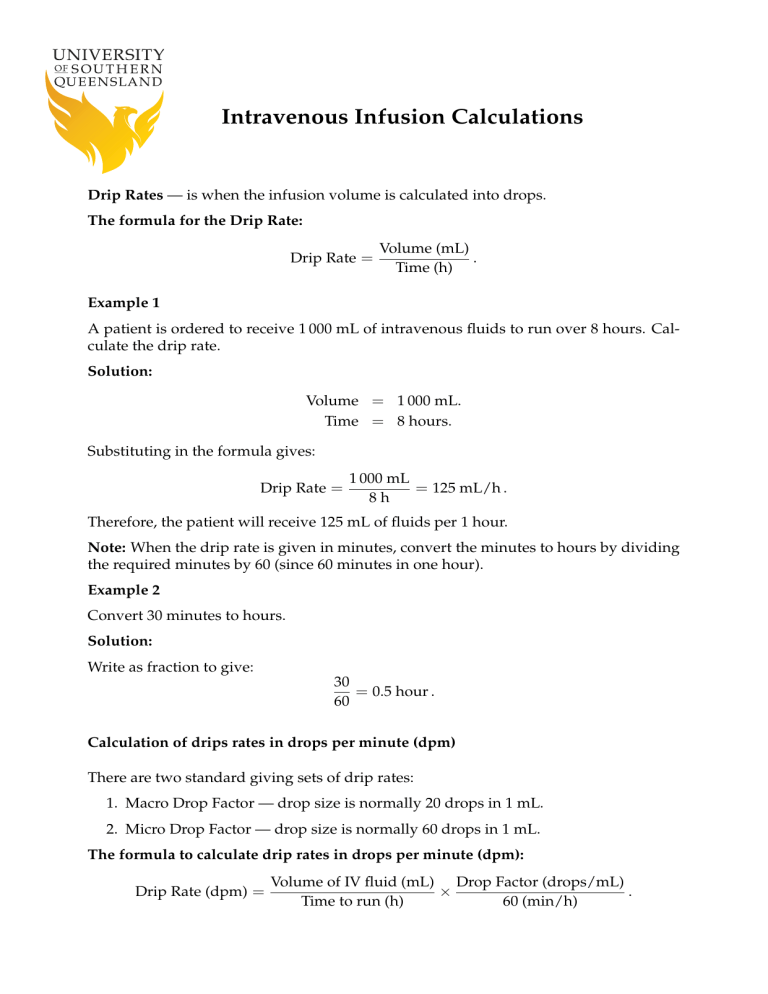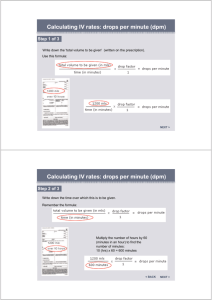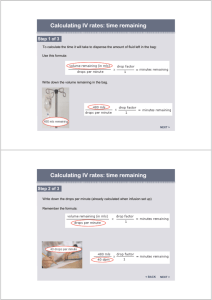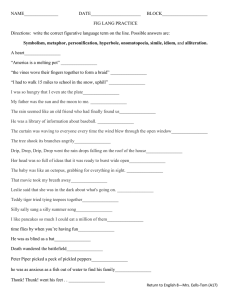
Intravenous Infusion Calculations Drip Rates — is when the infusion volume is calculated into drops. The formula for the Drip Rate: Drip Rate = Volume (mL) . Time (h) Example 1 A patient is ordered to receive 1 000 mL of intravenous fluids to run over 8 hours. Calculate the drip rate. Solution: Volume = 1 000 mL. Time = 8 hours. Substituting in the formula gives: Drip Rate = 1 000 mL = 125 mL/h . 8h Therefore, the patient will receive 125 mL of fluids per 1 hour. Note: When the drip rate is given in minutes, convert the minutes to hours by dividing the required minutes by 60 (since 60 minutes in one hour). Example 2 Convert 30 minutes to hours. Solution: Write as fraction to give: 30 = 0.5 hour . 60 Calculation of drips rates in drops per minute (dpm) There are two standard giving sets of drip rates: 1. Macro Drop Factor — drop size is normally 20 drops in 1 mL. 2. Micro Drop Factor — drop size is normally 60 drops in 1 mL. The formula to calculate drip rates in drops per minute (dpm): Drip Rate (dpm) = Volume of IV fluid (mL) Drop Factor (drops/mL) × . Time to run (h) 60 (min/h) Example 2 A patient is to receive 1 L of Hartmann’s solution over the next 12 hours. What is the rate of infusion in drops per minute (dpm), if the drop factor is 60 drops per mL . Solution: Volume = 1 000 mL, since 1 L = 1 000 mL. Time = 12 hours. Drop Factor = 60 drops per mL. Substituting these values into the drip rate formula gives: Drip Rate (dpm) = drops/ 1 000 mL 60 mL × = 83.833 ≈ 84 drops/minutes . min/ 12 h 60 h The formula to calculate how many hours will it take for the IV to complete before it runs out is: Volume (mL) Time (hours) = . Drip Rate (mL/hour) Example 3 The volume of the fluid is 1 000 mL and the IV pump set at 62 mL/hour. How long will it take for the fluid to run? Solution: Volume = 1000 mL. Time = 62 mL/hour. Substituting these values into the formula gives: Time (hours) = 1000 mL ≈ 16 hours . 62 mL/hour Other resources • Brotto and Rafferty (2016) • Reid-Searl, Dwyer, Moxham, and Reid-Speirs (2007) • Online resources at Study Support; • Arrange a consultation with a Mathematics Learning Advisor. References Brotto, V., & Rafferty, K. (2016). Clinical dosage calculations for Australia and New Zealand (2nd ed.). South Melbourne, Australia: Cengage Learning. Reid-Searl, K., Dwyer, T., Moxham, L., & Reid-Speirs, J. (2007). Nursing student’s maths & medications survival guide. Frenchs Forest, Australia: Pearson.




